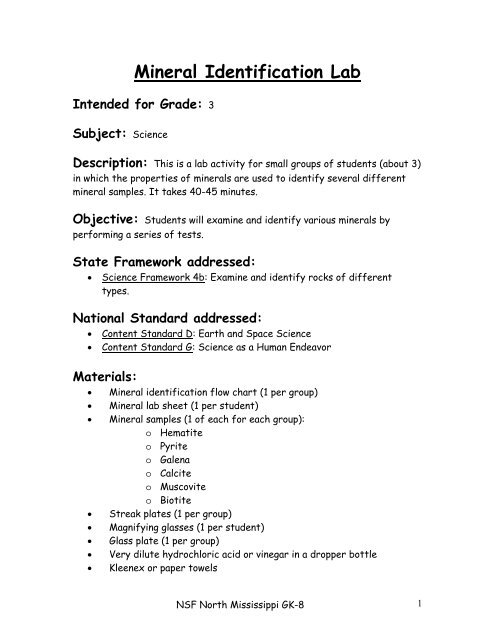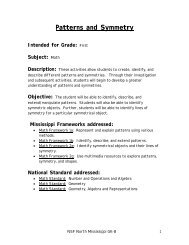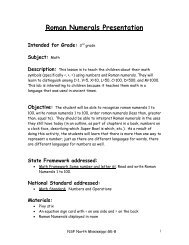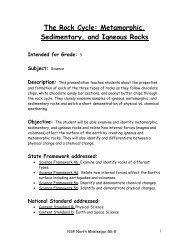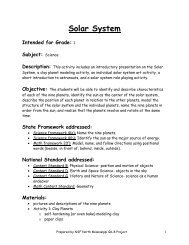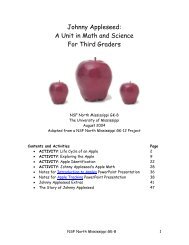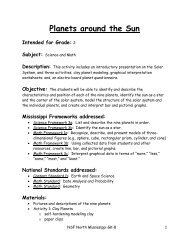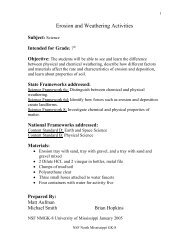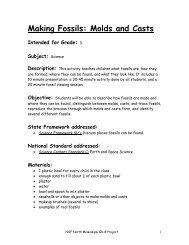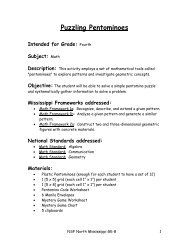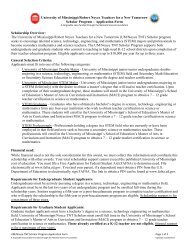Mineral Identification Lab - University of Mississippi
Mineral Identification Lab - University of Mississippi
Mineral Identification Lab - University of Mississippi
- No tags were found...
Create successful ePaper yourself
Turn your PDF publications into a flip-book with our unique Google optimized e-Paper software.
where to record the luster in the lab sheet (circle eithernonmetallic or metallic).9. The next property that needs to be identified is the mineral’sstreak. Remind the students that the streak is the color <strong>of</strong> themineral in powdered form. Allow one member <strong>of</strong> the group tomake one small line on the streak plate- just enough so that thecolor <strong>of</strong> the streak can be seen, but leaving enough room forthe other streaks to be tested as well. Show the studentswhere to record the color <strong>of</strong> the streak on the lab sheet.10. Next the students will need to record the mineral’s color.Show them where to record the color on the lab sheet, andpoint out that the mineral’s color is not always the same coloras the streak. The color <strong>of</strong> many <strong>of</strong> the minerals will bedebatable- allow the students to write whichever color theythink is closest. (It only really matters for the metallicminerals, which are either gold or silver in color.)11. The hardness will be the next property tested. One member<strong>of</strong> the group can try to scratch the glass plate with themineral. If the glass is scratched, the mineral is hard. If somemineral powder is produced, this usually means that the glasshas scratched the mineral, so the mineral is s<strong>of</strong>t. Check theglass plate very carefully for scratches, sometimes it is hard totell if the mineral left a “streak” or actually scratched theglass.12. Lastly the students will test or observe any special propertiesthe minerals may possess. Test or examine each mineral for all<strong>of</strong> the special properties listed in the background section <strong>of</strong>this activity. Each mineral will exhibit the special propertylisted in the table above.***Important: have an adult place one drop <strong>of</strong> very dilute HCl (orvinegar) on each sample. It should only fizz on the calcite sample.Then, immediately wipe the mineral clean with a Kleenex or papertowel. DO NOT allow the students to touch the acid. Even thoughit is very dilute it can still be irritating to the skin and eyes.NSF North <strong>Mississippi</strong> GK-8 4
Table salt (halite) crystals form as cubes. After about 12 hours, youshould be able to see small crystals forming at the bottom <strong>of</strong> the jar,on the paper clip, and along the string. Some may even form on thesurface <strong>of</strong> the water, like a wreath around the string. After 24 hours,you should see definite crystal forms.If you'd like to experiment with another mineral that has a completelydifferent shape, try using 1 and 1/2 cups <strong>of</strong> Epsom salts (magnesium sulfate)instead <strong>of</strong> 1/2 cup <strong>of</strong> salt. The Epsom salt crystals will tend to form on thebottom <strong>of</strong> the jar and are generally shaped like stubby prisms.Sources:Busch, R.M., ed., 1999, <strong>Lab</strong>oratory Manual in Physical Geology:American Geological Institute National Association <strong>of</strong> GeoscienceTeachers, 276 p.http://www.sdnhm.org/kids/minerals/grow-crystal.htmlPrepared by:Ashley PhillipsNSF NMGK-8<strong>University</strong> <strong>of</strong> <strong>Mississippi</strong>December 2003NSF North <strong>Mississippi</strong> GK-8 7
<strong>Mineral</strong> <strong>Identification</strong> <strong>Lab</strong> SheetSAMPLENUMBERLUSTER STREAK COLOR HARDNESSSPECIALPROPERTYMINERALNAME1 Metallic/NonmetallicS<strong>of</strong>t/hard2 Metallic/NonmetallicS<strong>of</strong>t/hard3 Metallic/NonmetallicS<strong>of</strong>t/hard4 Metallic/NonmetallicS<strong>of</strong>t/hard5 Metallic/NonmetallicS<strong>of</strong>t/hard6 Metallic/NonmetallicS<strong>of</strong>t/hardNSF North <strong>Mississippi</strong> GK-8
Start Here!Does your mineral look like a shiny piece <strong>of</strong> silver or gold?Yes, then your mineral is Metallic No, then your mineral is NonmetallicScratch your mineral on the streakplate. What color is the streak?Red/brown Silver/grayScratch your mineral on the streakplate. What color is the streak?White/yellow Brown/tanWhat color is the mineral?Gold SilverDoes the mineral fizz with acid or is themineral very flat and thin?Fizzy Thin and flatThis mineral iscalledHEMATITEThis mineral iscalled PYRITEThis mineral iscalled GALENAThis mineral iscalledCALCITEThis mineral iscalledMUSCOVITEThis mineral iscalled BIOTITE


